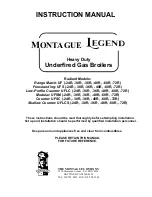
3
Matrix Installation and Operation Instructions
110
120
130
140
150
160
0-2000
3000
4000
5000
6000
7000
8000
9000
10000
Elevation (ft)
Input (Mbh)
Figure 1.1 Maximum Capacity vs. Altitude
1.0 SPECIFICATIONS
Model
CSA
Input
(MBH)
1,2
DOE
Heating
Capacity
(MBH)
1,3
Net
I=B=R
Rating
(MBH)
1,3
DOE
AFUE
(%)
3
Supply
Plenum
(inches)
Return
Plenum
(inches)
Airflow
Heating
(CFM)
Airflow
Cooling
(CFM)
Ventilation
(CFM)
Dimensions
H-W-D
(inches)
Vent/Air
Size
4
M100 25-150
136
118
95.1 22.5x18.5 18x18 400-1200
400-1600
-
53-28-38
3”
M100V 25-150
136
118
95.1 22.5x18.5
18x18 400-1200
400-1600 70-150
53-28-38
3”
Notes:
1 – Listed Input and Output ratings are at minimum vent lengths at Sea Level. Numbers will be lower with longer venting and/or altitudes greater then
2000 feet.
2 – The maximum output when operating on LP-Gas is limited to 145MBH.
3 – Based on rating plate input capacities, using standard test procedures prescribed by the U.S. Department of Energy. Ratings have been
confirmed by AHRI (GAMA).
4 – Matrix units require a special venting system, use only vent materials and methods detailed in these instructions.
1.1 High Altitude Operation
The Matrix is designed to operate to capacity
in installations at 2000 feet of elevation or
less. As elevations higher than 2000 feet
have less dense air, the unit is not capable of
providing its specified capacity. (See Chart).
In Canada:
De-rate by 5% for altitudes between 2000
and 4500 feet. For altitudes above 4500 feet
consult with local authorities.
In USA:
De-rate by 4% for every 1000 feet over 2000
feet.
CAUTION
AT ELEVATIONS GREATER THAN 2000 FEET, THE COMBUSTION OF THE MATRIX MUST BE CHECKED
WITH A CALIBRATED COMBUSTION TESTER TO ENSURE SAFE AND RELIABLE OPERATION. CONSULT
SECTION 5.20 FOR INSTRUCTIONS ON ADJUSTING THE INPUT TO PROVIDE PROPER OPERATION.
IT IS THE
INSTALLERS RESPONSIBILITY
TO CHECK THE COMBUSTION, AND
TO ADJUST THE COMBUSTION IN ACCORDANCE TO SECTION 5.20
Table 1.1 General Specifications




































